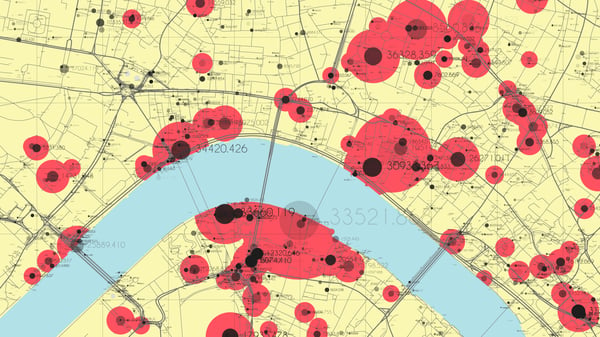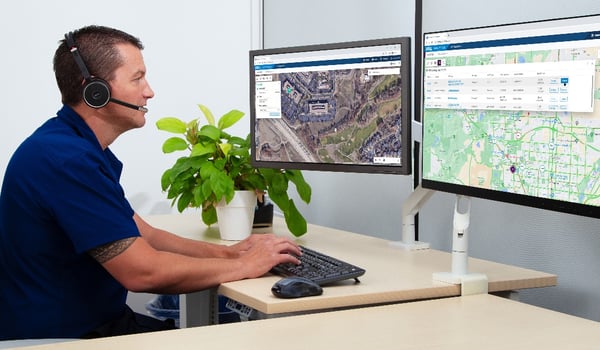4 Must-have Data Points for Dispatch-Billing Alignment and Maximum Reimbursement
How IoT Connects Ambulances & Improves Safety
You’ve likely heard of the Internet of Things, or its acronym IoT (eye – oh – tee)

You’ve likely heard of the Internet of Things, or its acronym IoT (eye – oh – tee). You might even be an expert on the topic, with all of your home appliances and devices already collecting data and presenting you the facts! Truth be told, I am a big fan of IoT, data, analytics, cloud, and Software as a Service (SaaS). In fact, I just pulled up flight tracking information for my daughter’s delayed flight to Peru to confirm she is finally off the ground and on her way. How cool is that?!
What is IoT?
IoT “enables objects to connect and exchange data.” Objects/things can be sensors, software, computers, wearables, mobile devices, etc., and the internet is what enables them to be connected to other objects. All of this allows consumers and businesses to track data about the things that matter to them, so that they can take action, when action is needed. Taking action is the point.
If you want to initiate change, improve efficiencies or save costs, for example, you first have to define the processes and measure the data.
Often times, people think of consumer products when the IoT topic comes up. This is likely because we are bombarded with advertising about smart watches, connected thermostats and doorbells, real-time refrigerator monitoring and the like. Do we really need to monitor our front door at home, via a camera doorbell, while at work? Some do, some don’t. But there’s more to it than that for businesses. You can’t manage what you can’t (don’t) measure. If you want to initiate change, improve efficiencies or save costs, for example, you first have to define the processes and measure the data. In fact, these are the first two steps in the well-defined data-driven Define, Measure, Analyze, Improve and Control (DMAIC) improvement cycle, which is a core tool in Six Sigma. DMAIC is used by organizations for stabilizing, improving and optimizing their business processes. The data are key. Without it, you will be acting on emotion and opinion, not facts.
How Does Road Safety Leverage IoT?
Road Safety embraced IoT, cloud and SaaS when we moved from the RS3000 to the RS4000. Our customers needed more data, faster and with easier access. We saw that the RS3000’s somewhat clunky transfer of data to a single, dedicated computer for analysis of Road Safety data was behind the times. Today, the RS4000 in-vehicle unit is an always connected device that collects data about each driver and each vehicle and sends that data to the cloud in real-time. The in-vehicle unit has substantial stand-alone value, in that it coaches drivers in real-time to aid them in becoming better drivers. This is a built-in take action system and is a major driver for changing driver behavior.
The exchange of vehicle and driver level Road Safety data up to ZOLL Online opens the door to many more capabilities including:
1. Efficiency of the Cloud. Because all Road Safety data from all vehicles and all drivers immediately pushes to ZOLL Online, you don’t have to piece together data from multiple sources to gain insights. Having all of the data consolidated in one location allows you to do agency-wide trend reporting and analysis, compare and rank all drivers across any timeline, identify who is meeting company standards and who isn’t, see runs on a map, or analyze second by second details. These are all necessary components of a driver safety program made seamlessly possible by having all of the information in one location.
The centralization of data is equally as valuable when it comes to administering and configuring the RS4000 units for each vehicle. For any configuration changes you wish to make – such as managing drivers or changing violation thresholds – you make a single configuration change via ZOLL Online and it automatically propagates to ALL RS4000 connected units across your fleet. This not only saves time, but also makes it easier to try new settings and thresholds as you identify what works best for your organization.
2. Take Action in Real-Time with Alerts. Monitoring behavior through reporting and analytics, as mentioned above, is an important task. Sometimes, however, there are items for which you want immediate proactive alerts, so that you can promptly ensure the safety of your crew and vehicles. Alerting from connected devices gives you immediate intelligence. The most frequently used alerts in Road Safety are for check engine light, potential impacts and extreme over speed violations. Having these alerts delivered in real time – much like the drivers getting real-time audible coaching in vehicle – provides administrators and safety managers notice that they need to take action.
3. Stay on Top of Your Safety Program. On-going organizational support of a driver safety program is crucial. The “set it and forget it” method doesn’t work. To be the best at what you do, you have to regularly monitor, tweak and enhance your safety program. To do so, you have to be proactive in analyzing the health and status of your overall program, including the actions of the participants in your program and the thresholds you choose to monitor. Don’t ignore the data. It’s all there. Seek it out.
4. Manage Your Fleet. A major component of fleet management is to track the location of vehicles. Knowing the location of your vehicles can aid in minimizing response times by responding with the closest ambulance. Road Safety captures the GPS location of each vehicle and sends it to ZOLL Online and @Work in real time where the vehicles display on a map.
More Benefits of a Connected Ambulance
The wider appeal of a connected ambulance is to be able to monitor anything that matters and the ability to send that information anywhere you want and connect it to any other data you want. Doing so improves processes and, ultimately, outcomes. Beyond Road Safety, EMS uses many connected devices within ambulances today. This includes dispatch and navigation systems that aid in the response to an event, cardiac monitoring that can send vitals and 12-leads to hospitals ahead of arrival, patient care reports, and mobile data terminals (MDT). ZOLL Road Safety customers have made requests to monitor medicine cabinet locks and doors, patient compartment seatbelts, cabin lights, door ajar, and even gas door open/close status. We’ve also heard from agencies wanting to improve their inventory management using RFID tags on the equipment inside the ambulance. Clearly, the industry understands the value that comes from monitoring, measuring and sharing data wherever and whenever possible.
As I complete this blog post, I am writing from home as my water heater is being replaced. We had an issue with the water heater that created a carbon monoxide problem. My connected NEST carbon monoxide monitor recognized the problem, provided audible notification of the problem (like Road Safety’s in-vehicle tones) and sent an alert to my mobile phone (like Road Safety alerts). The really cool thing about it is that I was notified of the problem, in a polite way (like Road Safety growls), well before the very loud emergency alarm went off. I decided long ago that I wanted more intelligence about the potential “silent killer,” carbon monoxide, in my home and an IoT connected device plan worked/works for me. In the Road Safety world, your silent killer may be reckless driving. It’s not really silent, but is too often a killer. Are you identifying and connecting the dots?
Related Posts
How EMS Agencies Can Reframe Need and Refocus Resources With Geospatial Analytics
How To Minimize Radio Chatter and Reduce Guesswork With Smarter Dispatch Resource Management
ZOLL Pulse Blog
Subscribe to our blog and receive quality content that makes your job as an EMS & fire, hospital, or AR professional easier.
ZOLL Pulse Blog
Subscribe to our blog and receive quality content that makes your job as an EMS, fire, hospital, or AR professional easier.





